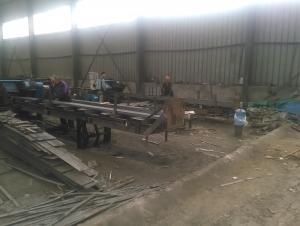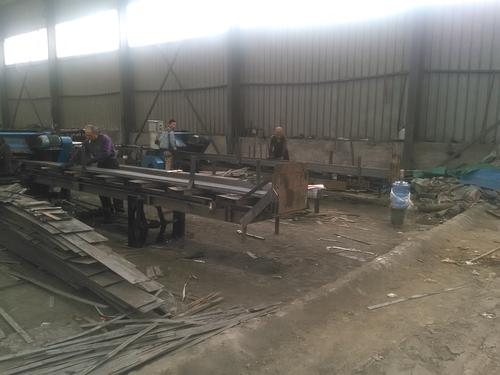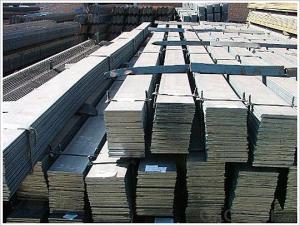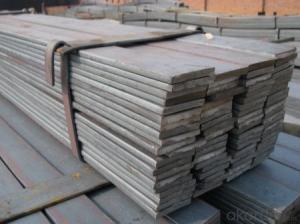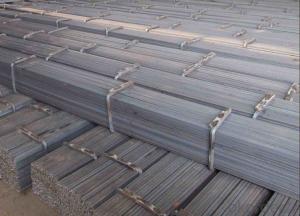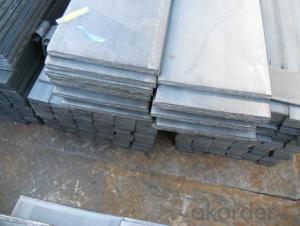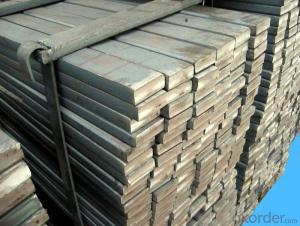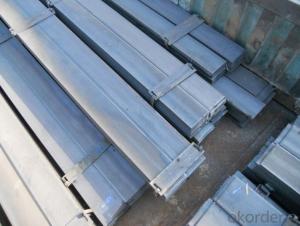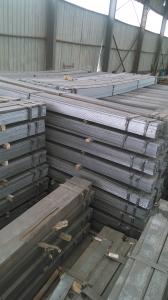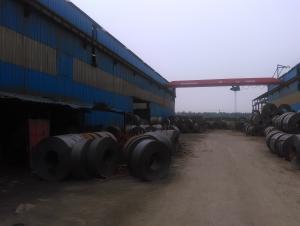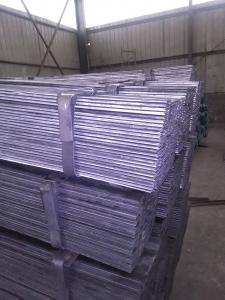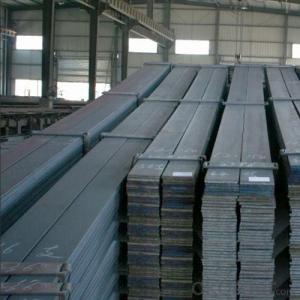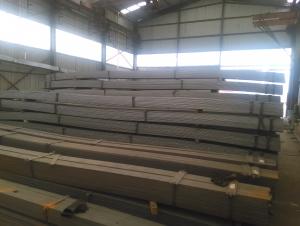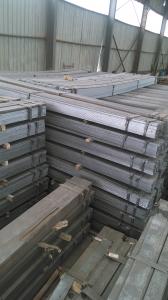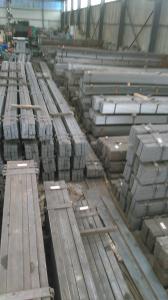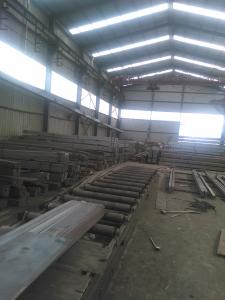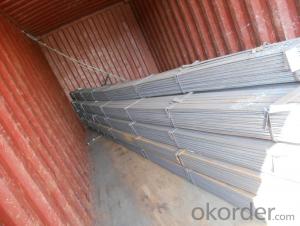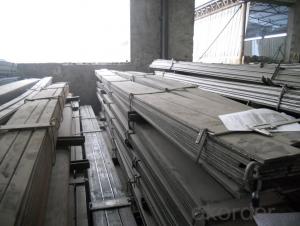ASTM A36 Steel Flat Iron Bars with Variety Sizes
- Loading Port:
- Tianjin
- Payment Terms:
- TT or LC
- Min Order Qty:
- 100 m.t.
- Supply Capability:
- 10000T m.t./month
OKorder Service Pledge
OKorder Financial Service
You Might Also Like
Product Description:
OKorder is offering ASTM A36 Steel Flat Iron Bars with Variety Sizes at great prices with worldwide shipping. Our supplier is a world-class manufacturer of steel, with our products utilized the world over. OKorder annually supplies products to African, South American and Asian markets. We provide quotations within 24 hours of receiving an inquiry and guarantee competitive prices.
Product Applications:
ASTM A36 Steel Flat Iron Bars with Variety Sizes are ideal for structural applications and are widely used in the construction of buildings and bridges, and the manufacturing, petrochemical, and transportation industries.
Product Advantages:
OKorder's ASTM A36 Steel Flat Iron Bars with Variety Sizes are durable, strong, and wide variety of sizes.
Main Product Features:
· Premium quality
· Prompt delivery & seaworthy packing (30 days after receiving deposit)
· Can be recycled and reused
· Mill test certification
· Professional Service
· Competitive pricing
Product Specifications:
Manufacture: slited
Slitting precision (width) : 0.5 mm or less
Raw material: Q235B, Q345B, Q235-1 b, A36
crosscutting precision (length) : 2 mm or less
Processing: the thickness of 2.0-16 mm;
Shear length: 2000 mm above
Wide degree: 15-1250 - mm;
Leveling precision: 1-2 MM square
Packaging: Export packing, nude packing, bundled
FAQ:
Q1: How many tons of steel products could be loaded in containers?
A1: Usually the steel products are delivered by bulk vessel because of the large quantity and the freight. However, there are no bulk vessel enter some seaports so that we have to deliver the cargo by containers. The 6m steel product can be loaded in 20FT container, but the quantity is changed according to the size, usually from 18tons to 25tons.
Q2: How do we guarantee the quality of our products?
A2: We have established an advanced quality management system which conducts strict quality tests at every step, from raw materials to the final product. At the same time, we provide extensive follow-up service assurances as required.
Q3: How soon can we receive the product after purchase?
A3: Within three days of placing an order, we will arrange production. The normal sizes with the normal grade can be produced within one month. The specific shipping date is dependent upon international and government factors, the delivery to international main port about 45-60days..
Images:
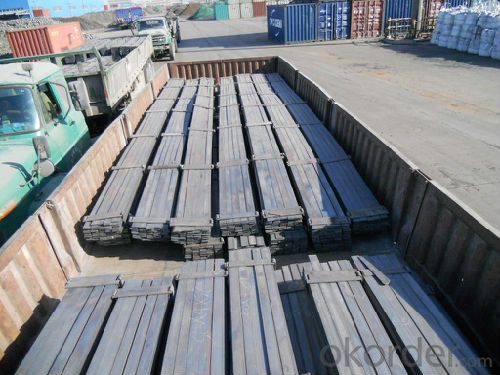
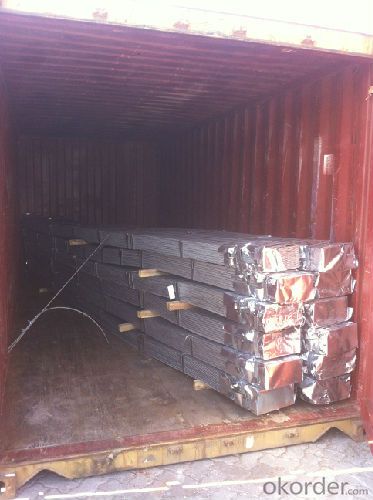
- Q: How do you store and transport steel flat bars safely?
- To store and transport steel flat bars safely, there are several key steps to follow: 1. Proper stacking: When storing steel flat bars, it is important to stack them properly to prevent any damage. Ensure that the bars are stacked horizontally and evenly, with each layer aligned. The weight should be distributed evenly across the stack to maintain structural integrity. 2. Adequate support: Use sturdy supports such as appropriately sized pallets or racks to prevent any sagging or bending of the bars. Make sure that the supports are capable of handling the weight and size of the steel flat bars. 3. Securing the stack: To prevent the bars from shifting during transportation, it is necessary to secure the stack using straps or bands. These should be tightly fastened around the stack, ensuring that the bars are secure and won't move during transit. 4. Protective measures: Steel flat bars are susceptible to corrosion, especially when exposed to moisture. Therefore, it is crucial to protect them from environmental elements during storage and transportation. Consider using protective covers or wrapping the bars in moisture-resistant materials to prevent rust or damage. 5. Proper lifting and handling: When moving steel flat bars, it is important to use appropriate lifting equipment, such as forklifts or cranes, to avoid any injuries or accidents. Ensure that the lifting equipment is capable of handling the weight of the bars and that operators are well-trained in safe lifting practices. 6. Special considerations for long-distance transportation: If transporting steel flat bars over long distances, it may be necessary to use specialized shipping containers or trucks that are equipped to handle heavy loads and provide adequate protection from external elements. Overall, the key to safe storage and transportation of steel flat bars lies in proper stacking, adequate support, securing the stack, protective measures, and employing the right lifting and handling techniques. Adhering to these guidelines will help minimize the risk of damage, accidents, and corrosion, ensuring the safe delivery of steel flat bars to their destination.
- Q: Can steel flat bars be used for manufacturing sports equipment or accessories?
- Steel flat bars have the capability to be utilized in the production of sports equipment and accessories. Steel, being a sturdy and long-lasting material, can endure the demands of sports activities. Steel flat bars can be molded and crafted into a variety of products, including baseball bats, golf clubs, weightlifting bars, bicycle frames, and more. The adaptability of steel enables it to be tailored and adjusted to meet specific sporting requirements. Moreover, the ease of welding steel flat bars offers additional flexibility during the manufacturing process. In conclusion, steel flat bars are an appropriate choice for manufacturing sports equipment and accessories due to their strength, durability, and capacity to be shaped into desired forms.
- Q: Do steel flat bars have a specific grain orientation?
- No, steel flat bars do not have a specific grain orientation. Unlike materials such as wood or some types of metals, steel does not possess a visible grain structure. Steel is an alloy composed mainly of iron and carbon, along with other elements, and its microstructure consists of tiny crystals called grains. However, these grains are randomly oriented in steel, meaning there is no particular direction or pattern to the grain orientation in flat bars. This random grain structure contributes to the isotropic properties of steel, making it equally strong and durable in all directions.
- Q: Can steel flat bars be used in automotive manufacturing?
- Indeed, automotive manufacturing can make use of steel flat bars. These bars find widespread application in the automotive industry owing to their robustness, resilience, and adaptability. They serve as a vital component in the production of diverse automotive parts including brackets, supports, frames, hinges, and reinforcements. Steel flat bars possess exceptional structural integrity and possess the ability to endure substantial loads, rendering them highly suitable for automotive manufacturing. Moreover, steel emerges as a cost-effective material that is easily accessible, thereby making it a favored selection in the automotive sector.
- Q: Can steel flat bars be used for structural support?
- Yes, steel flat bars can be used for structural support. They are commonly used in construction projects to provide stability and support in various applications such as beams, columns, braces, and frames. The high strength and durability of steel make it an ideal material for structural support, ensuring the safety and stability of the structure.
- Q: Can steel flat bars be used for manufacturing machine guards?
- Yes, steel flat bars can be used for manufacturing machine guards. Steel is a durable and strong material that provides excellent protection against impact and other potential hazards. Flat bars can be easily shaped and welded to create customized machine guards that meet the required safety specifications.
- Q: Can steel flat bars be used as supports for shelves or countertops?
- Steel flat bars are indeed suitable for supporting shelves or countertops. Given their strength and durability, steel is an ideal material for providing excellent support to heavy objects. In particular, the flat and wide surface of flat bars is well-suited for this purpose as it evenly distributes weight and reduces the likelihood of sagging or bending. Moreover, steel's resistance to moisture and corrosion makes it a dependable option for areas that are susceptible to humidity or spills. Nevertheless, it is crucial to ensure that the steel flat bars are appropriately sized and securely fastened to the wall or structure in order to guarantee stability and safety.
- Q: What is the thickness tolerance for steel flat bars?
- The thickness tolerance for steel flat bars can vary depending on the specific grade and manufacturing standard being followed. However, in general, the industry standard tolerance for steel flat bars is typically +/- 0.005 inches (0.127mm) to +/- 0.010 inches (0.254mm). This means that the actual thickness of a steel flat bar can deviate within this range from the specified nominal thickness. It is important to consult the relevant manufacturing standard or supplier specifications for the specific tolerance requirements of the steel flat bars being considered.
- Q: The difference between galvanized round bar and galvanized flat steel
- Galvanized round bar and galvanized flat steel are of different shapes and different uses.
- Q: Can steel flat bars be bent or shaped according to specific requirements?
- Steel flat bars have the capability to be bent or shaped to meet specific needs. These bars are typically crafted from mild steel, which possesses excellent malleability and ductility. As a result, it can be effortlessly bent or shaped without any risk of cracking or breaking. Achieving the desired bend or shape can be accomplished through a range of techniques including hot or cold bending, rolling, or employing specialized machinery such as hydraulic presses or bending brakes. The precise requirements for bending or shaping the steel flat bars will depend on factors such as the desired angle or curve, the thickness and width of the bar, and the intended application. Overall, steel flat bars present a flexible and cost-efficient solution for a variety of construction, manufacturing, and fabrication projects.
Send your message to us
ASTM A36 Steel Flat Iron Bars with Variety Sizes
- Loading Port:
- Tianjin
- Payment Terms:
- TT or LC
- Min Order Qty:
- 100 m.t.
- Supply Capability:
- 10000T m.t./month
OKorder Service Pledge
OKorder Financial Service
Similar products
Hot products
Hot Searches
Related keywords
